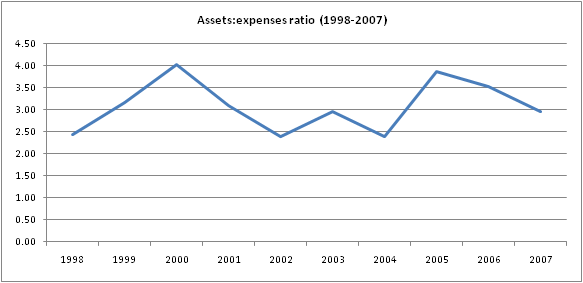In Part I, I laid out my case for The Carter Center, and why we think they’re worth investigating deeply. I also said that we’re not yet ready to recommend them because we have some unanswered questions. Here they are:
Relevance of your donation
When I give, I want to know that the organization needs my support and is going to accomplish more good (than they otherwise would have) because of my support. Because of The Carter Center’s strong track record, I wonder whether they can already effectively raise all the money they want. That is, I wonder whether money isn’t the bottleneck to serving more people. That question is supported by looking at Carter’s current financial situation. Revenues have risen roughly in-line with expenses over the past few years (see chart 1 below), maintaining their (relatively large) assets:expense ratio of 3:1 (see chart 2, below). All data comes from Carter Center annual reports, available on their website here.


Many of The Carter Center’s programs have extremely strong independent evidence supporting them (e.g., their guinea worm, river blindness, lymphatic filariasis, and schistosomiasis programs). These programs also have the type of strong, consistent monitoring I mentioned in the previous post. However, the evidence case for some of their other programs is weaker (in particular their trachoma, agriculture, and public health training initiative), and the monitoring provided for those programs is both a) less consistent and b) less compelling than the monitoring provided for the others.
Running some less-proven projects doesn’t necessarily mean we won’t recommend them, especially if those programs are relatively small, but:
Lack of financial transparency
The Carter Center is one of the (if not the) most transparent organizations I’ve ever come across when it comes to monitoring their activities. Carter not only lays out what they do in extreme detail — for the intrepid, the most recent river blindness program report (PDF) is representative of Carter Center monitoring — they discuss program trade-offs they make, lessons they’ve learned, and potential future obstacles. But, they don’t publish any cost data on their website, other than the very broad and general 990 data and some sporadic program-specific information. To properly evaluate The Carter Center, we need to know the portion of the budget that’s allocated to any less-proven programs. In addition, we want tell you what your donation accomplishes to The Carter Center. Does $1,000 prevent 1 case of blindness? 2? 10? We need better information on costs to make that call.
Those are the questions we’re working on answering now. Whatever we find, you’ll get our answers soon.
